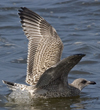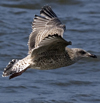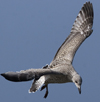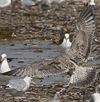 Herring Gull- Zilvermeeuw (argentatus & argenteus)
Herring Gull- Zilvermeeuw (argentatus & argenteus)
(last update: December 15, 2011
Herring Gull - 1cy July
Introduction
This website deals with the Herring Gulls of the taxa argentatus and argenteus. Argenteus is an abundant breeding species on Iceland, Britain, NW France, Belgium, the Netherlands and N Germany. The taxon argentatus breeds in NE Europe, from Denmark, the coast of the Baltic Sea, Scandinavia and coast of the White Sea. In the centre of the breeding range (Denmark and the NW German coast), birds show intermediate characteristics, indicating there is a cline in argenteus-argentatus. Argenteus in Western Europe is pale-backed, slightly smaller and with relatively much black in the wing-tip; argentatus in the NE Europe is larger, slightly darker on upper-parts and show less black in the wing-tip.
Due to the large breeding range, there is much intra-specific variation in argentatus, with most large, powerful birds in the northern populations, showing the most darkest upper-parts, longest wing and most white in the outer-wing. In this region, some populations may hold substantial number of yellow-legged argentatus. (referred to as "Finnmark yellow-legged argentatus"). In adult plumage, the black sub-terminal spot on P5 is often lacking or strongly reduced to a diffuse streak, broken at the centre. Sometimes P6 lacks black as well.
In the Baltic region, other yellow-legged argentatus populations occur ("Baltic yellow-legged argentatus"), with adults showing even brighter yellow legs in summer and the upper-parts only slightly darker than West European argenteus, still much paler than Yellow-legged Gull (michahellis). Those Baltic argentatus often show a black sub-terminal spot on P5 in adult plumage.
On these web-pages, we largely follow P.J. Grant: "Gulls, a guide to identification" and E.K Barth's publication as Contribution No. 86, Zoological Museum, University of Oslo: "The circumpolar systematics of Larus argentatus and Larus fuscus with special reference to the Norwegian populations".
1cy Herring Gull: description for July
In juvenile plumage, the head and under-parts are streaked grey-brown, rather pale on forehead and throat and with dark ear-coverts. The mantle and scapulars are brown based with buffish-yellowish fringes when the feathers are fresh. The notched pattern is repeated on the lesser, lower lesser and median coverts, although the medians often have paler centres. The greater coverts show a 'piano-key' pattern, obvious on the outer greater coverts as well in western populations (British argenteus). Some 1cy July argentatus (e.g. this argenteus and this argentatus) may have the outer greater coverts with extensive dark centres, lacking obvious notching and thin fringes on the tertials, like in michahellis. On average, the tertials have an obvious notched pale fringe and transversal bar. Again, this is more pronounced in argenteus than in argentatus. The secondaries, primaries and primary coverts are dark with a small white tip, but the inner primaries show an obvious, sometimes translucent, pale window, prominent from below and above. The under-wing is rather uniform grey-brown patterned. The tail has a broad sub-terminal band and isolated dark bars on the basal half. Some argentatus show a broken tail-band, reminiscent to Great Black-backed Gull (L. marinus). The iris is very dark, the bill is blackish, sometimes with a paler base, and the legs are flesh-pink with dark shins.
1cy Herring Gull: post-juvenile moult
The partial autumn moult (moult into so-called "first winter" plumage) includes the body and head feathers. This moult starts as soon as the nest is abandoned (especially in southern populations) and continues until January. Early argenteus juveniles fledge by late-June in the Netherlands, argentatus fledge mid-July in northern USSR. The post-juvenile moult is most extensive in southern Herring Gull populations. Northern juvenile argentatus may postponed the post-juvenile moult until February, hence retain a juvenile plumage (e.g. this Russian 2cy argentatus in February).
In the post-juvenile moult, the head turns paler on throat and forehead. The breast turns paler as well, but most is an effect of bleaching and wear. The feathers on belly and vent remain juvenile in most 1cy argenteus by November.
From 1cy July onwards, the mantle and upper scapulars may be moulted to second generation feathers, showing an anchor pattern and a dark base. When the feathers are fresh, they may show warm ginger tones, but after a few weeks these warm tones bleach paler, to white later in the season. In 2cy argenteus in NW France (from Belgian, Dutch and British populations), the lowest row of scapulars are still juvenile by 2cy March in the vast majority of birds (contra e.g. the southern taxon michahellis). Both argenteus and argentatus normally exclude all tertials and wing-coverts from the post-juvenile moult. However, we estimate 2-4% of argenteus to include one or a few wing-coverts or a single tertial in the post-juvenile moult (often in a later stage of this moult, when scapular moult is well underway). We don't have sufficient data to estimate for argentatus, but several pictures show this phenomenon in argentatus as well. The juvenile wing-coverts, rectrices and remiges start to bleach and show wear in the fringes from 1cy September onwards.
1cy July argenteus is normally in complete juvenile plumage. Most advanced birds have a few upper scapulars and some mantle feathers replaced. Active moult is obvious by the moult gaps. 1cy argenteus in the Netherlands still have to grown the outer primaries by mid-July, as can be seen in the images.
1cy Herring Gull July: tables
to include:
1. table with scapular moult July 1cy argenteus Netherlands.
2. table with scapular moult July 1cy argentatus Finland.
 Herring
Gull K.C 1cy (argenteus), July 24 2013, Katwijk, the Netherlands.
Herring
Gull K.C 1cy (argenteus), July 24 2013, Katwijk, the Netherlands. Herring
Gull Y.BTH 1CY (argenteus), July 30 2014, IJmuiden, the Netherlands.
Herring
Gull Y.BTH 1CY (argenteus), July 30 2014, IJmuiden, the Netherlands. Herring
Gull K.ACM 1cy (argenteus), July 25 2010, Texel, the Netherlands.
Herring
Gull K.ACM 1cy (argenteus), July 25 2010, Texel, the Netherlands. Herring
Gull K.ACS 1cy (argenteus), July 25 2010, Texel, the Netherlands.
Herring
Gull K.ACS 1cy (argenteus), July 25 2010, Texel, the Netherlands. Herring
Gull K.ACX 1cy (argenteus), July 25 2010, Texel, the Netherlands.
Herring
Gull K.ACX 1cy (argenteus), July 25 2010, Texel, the Netherlands. Herring
Gull K.AFN 1cy (argenteus), July 25 2010, Texel, the Netherlands.
Herring
Gull K.AFN 1cy (argenteus), July 25 2010, Texel, the Netherlands. Herring
Gull 1cy (argenteus), July 30 2014,
IJmuiden, the Netherlands.
Herring
Gull 1cy (argenteus), July 30 2014,
IJmuiden, the Netherlands. Herring
Gull 1cy (argenteus), July 30 2014,
IJmuiden, the Netherlands.
Herring
Gull 1cy (argenteus), July 30 2014,
IJmuiden, the Netherlands. Herring
Gull 1cy (argenteus), July 30 2014,
IJmuiden, the Netherlands.
Herring
Gull 1cy (argenteus), July 30 2014,
IJmuiden, the Netherlands. Herring
Gull 1cy (argenteus), July 30 2014,
IJmuiden, the Netherlands.
Herring
Gull 1cy (argenteus), July 30 2014,
IJmuiden, the Netherlands. Herring
Gull 1cy (argenteus), July 30 2014,
IJmuiden, the Netherlands.
Herring
Gull 1cy (argenteus), July 30 2014,
IJmuiden, the Netherlands. Herring
Gull 1cy (argenteus), July 30 2014,
IJmuiden, the Netherlands.
Herring
Gull 1cy (argenteus), July 30 2014,
IJmuiden, the Netherlands. Herring
Gull 1cy (argenteus), July 30 2014,
IJmuiden, the Netherlands.
Herring
Gull 1cy (argenteus), July 30 2014,
IJmuiden, the Netherlands. Herring
Gull 1cy (argenteus), July 30 2014,
IJmuiden, the Netherlands.
Herring
Gull 1cy (argenteus), July 30 2014,
IJmuiden, the Netherlands. Herring
Gull 1cy (argenteus), July 30 2014,
IJmuiden, the Netherlands.
Herring
Gull 1cy (argenteus), July 30 2014,
IJmuiden, the Netherlands. Herring Gull (argenteus) 1CY, July 31 2015, Noordwijk, the Netherlands.
Herring Gull (argenteus) 1CY, July 31 2015, Noordwijk, the Netherlands.  Herring Gull (argenteus) 1CY, July 31 2015, Noordwijk, the Netherlands.
Herring Gull (argenteus) 1CY, July 31 2015, Noordwijk, the Netherlands.  Herring Gull (argenteus) 1CY, July 31 2015, Noordwijk, the Netherlands.
Herring Gull (argenteus) 1CY, July 31 2015, Noordwijk, the Netherlands.  Herring Gull (argenteus) 1CY, July 31 2015, Noordwijk, the Netherlands.
Herring Gull (argenteus) 1CY, July 31 2015, Noordwijk, the Netherlands.  Herring Gull (argenteus) 1CY, July 31 2015, Noordwijk, the Netherlands.
Herring Gull (argenteus) 1CY, July 31 2015, Noordwijk, the Netherlands.  Herring
Gull 1cy (argenteus), July 18 2013, Katwijk, the Netherlands. P6/P9.
Herring
Gull 1cy (argenteus), July 18 2013, Katwijk, the Netherlands. P6/P9. Herring
Gull 1cy (argenteus), July 18 2013, Katwijk, the Netherlands. P6/P9.
Herring
Gull 1cy (argenteus), July 18 2013, Katwijk, the Netherlands. P6/P9. Herring
Gull 1cy (argenteus), July 18 2013, Katwijk, the Netherlands. P6/P9.
Herring
Gull 1cy (argenteus), July 18 2013, Katwijk, the Netherlands. P6/P9. Herring Gull (argenteus) 1CY, July 31 2015, Noordwijk, the Netherlands.
Herring Gull (argenteus) 1CY, July 31 2015, Noordwijk, the Netherlands.  Herring Gull (argenteus) 1CY, July 31 2015, Noordwijk, the Netherlands.
Herring Gull (argenteus) 1CY, July 31 2015, Noordwijk, the Netherlands.  Herring Gull (argenteus) 1CY, July 31 2015, Noordwijk, the Netherlands.
Herring Gull (argenteus) 1CY, July 31 2015, Noordwijk, the Netherlands.  Herring
Gull 1cy (argentatus), July 11 2003, Tampere, Finland (61.31N, 23.43E).
Herring
Gull 1cy (argentatus), July 11 2003, Tampere, Finland (61.31N, 23.43E). Herring
Gull 1cy (argentatus), July 15 2003, Tampere, Finland (61.31N, 23.43E).
Herring
Gull 1cy (argentatus), July 15 2003, Tampere, Finland (61.31N, 23.43E).